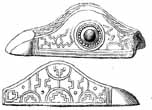|
head-dress, and closely resembling that described under Grave IV.
The pendant, also, is much like those found in that grave
|
and of the medium size there described. At its edge
is a beading, and within it an ornamented border; the centre bears
those strange figures so common upon these ornaments, and, as
Professor Stephens of Copenhagen informs me, quite familiar
|

|
to northern antiquaries, and of
frequent occurrence throughout Scandinavia. "The ground type," he
writes to me, "is a writhed worm with gaping jaws, and headless
intertwining snakes, all making, as it were, one serpent." Numerous
examples of these golden bracteates are given in Thomsen’s ‘Atlas de l’Archéologue
du Nord,’ some exactly resembling these found at Sarr, others differing
|
|
widely from them. But these are evidently debased copies of the Scandinavian
type, possibly the spoil of Danish invaders, but more probably the work of
the Jutes themselves or of foreign artists employed by them, and degenerated
from the original designs brought over at their first immigration
|
No. CXI. — A broken umbo and a bronze sword pommel.1
|

|
1 [The sword-pommel of which
an engraving is annexed was
|
also found in one of this year’s graves, but
unfortunately the particular grave was omitted to be noted. It is too
elegant to be passed over, and is, besides, of an unusual type: I have
therefore placed it here. It is of silver and very prettily chased, and on
one side is set with a small round carbuncle.—T. G. F.]
|

|
|